20,000 March for Pensions & Against Cuts
London, UK. Thursday 23 June 2011
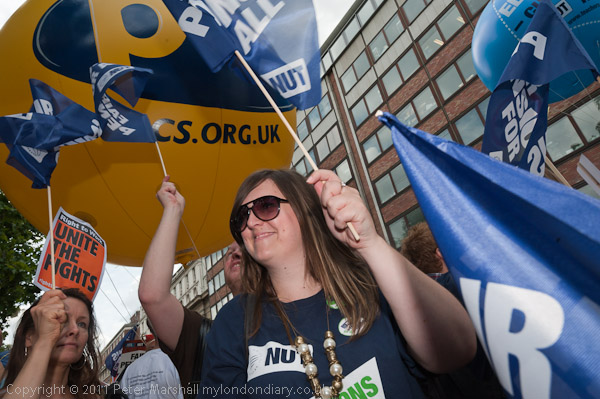
The BUT, ATL, PCS and others gathered in Lincolns Inn Fields to march to Westminster.
more pictures
The march through London organised by public services unions against pension cuts attracted many thousands of union members as well as many others protesting against cuts in public services. London, UK. 30 June 2011.
I joined a large crowd already in Lincoln's Inn Fields for the protest over an hour before it was due to begin, and people were still arriving as it left a few minutes early as police and organisers were worried about the overcrowding.
At Lincoln Inn's Fields there were speeches from several of the union leaders and others, and the march was led away towards Westminster by Christine Blower NUT, Mark Serwotka PCS and Mary Bousted ATL along with MP John McDonnell.
The campaign by the unions has already managed to get across the point that the government had lied in saying that public service pensions were not affordable, as the Hutton pension review clearly showed that they were reducing from a maximum last year. Several speakers and well as many other people on the march commented on the clear way in which Francis Maude's argument on the Today programme earlier in the day had been refuted not just by Mark Serwotka of the PCS, but by interviewer Evan Davies who pointed out to him that Hutton had said nothing of the kind, quoting the report which "projected benefit payments to fall gradually to around 1.4 per cent of GDP in 2059-60, after peaking at 1.9 per cent of gross domestic product (GDP) in 2010-11."
The march was a peaceful one, though people got a little agitated when it was held up by police on the Strand for around 20 minutes, and there was a great deal of noisy shouting as it passed Downing St on its way to Westminster Central Hall for a further rally.
Everywhere there seemed to be very large numbers of police, and there were barriers all along Whitehall keeping the protesters to the side furthest from Downing St. The level of policing throughout London seemed entirely unnecessary for what was largely a demonstration by teachers and civil servants. There were very few of the more militant elements present, with only a token presence from militant students and anarchists.
I stood outside Central Hall for around an hour as more and more people filed past, finally giving up waiting for an end to the march - or rather marches, as the main march had been joined by several others from other parts of London.
In Lincoln's Inn Fields, police appeated to be conducting stop and searches on any young male demonstrators in black clothing. I saw only two other minor incidents involving the police, one close to Central Hall where police and march stewards objected to Charlie Veitch and other 'Love Police' haranguing the crowd in his usual deadpan fashion upholding his right to freedom of expression. After a few minutes he and his group moved away to continue elsewhere.
Later, close to the overflow rally in Tothill Street, one or two police officers approached a small group - perhaps 20 or 30 protesters mainly dressed in black - and asked a couple of the young men with with hoods up and insisted that they remove them or be arrested. None of them were masked, although some were wearing dark glasses.
Arguments then developed between police and demonstrators, including some Muslim women who asked if the police would insist on them removing their headscarves - and were told they would not. I saw one young man who finally agreed to remove his dark glasses and lift up his hood, but eventually the police withdrew, with some of them saying that they had called for FIT (Forward Intelligence Teams) to attend.
The rally inside Central Hall and the overflow outside was coming to an end
and people were drifting away and I decided to leave. Later there were a few
scuffles in Whitehall and a group of twenty or thirty were kettled for a few
hours in Trafalgar Square.
more pictures
Save UK Democracy From Murdoch
Dept Culture, Media & Sport, Thursday 23 June 2011
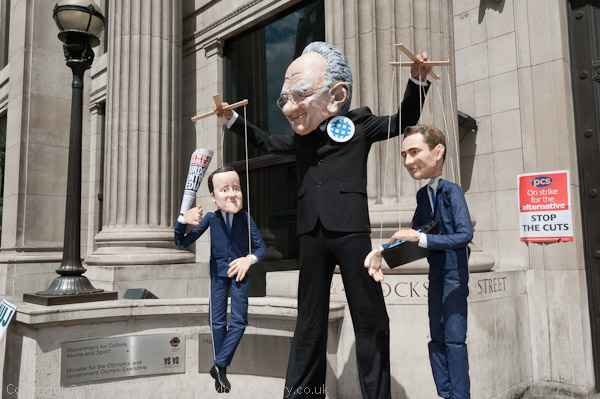
Avaaz, the NUJ and others protested against allowing
Murdoch to take over BSkyB
more pictures
On-line global campaign network Avaaz organised 'Save UK media and democracy' rally outside the Department of Culture, Media and Sport against minister Jeremy Hunt's decision to allow Rupert Murdoch to take over BSkyB.
This was an emergency protest, called within minutes of most of us hearing the announcement by Jeremy Hunt that he would allow the takeover, and was thus a fairly small event. Many of those who might otherwise have responded to this morning's e-mail from Avaaz were probably already on their way to work or taking part in today's public services strikes and demonstrations against the cuts.
It included a tall stilt walker with a large but rather inappropriately avuncular head of Rupert Murdoch, surely one of the ugliest figures in world media and pursuing a clear aim of world domination, toying with two large string puppets representing David Cameron and Jeremy Hunt.
Taking part with Avaaz was the NUJ, whose members are appalled like most
of the thinking population by the thought of the UK's largest commercial broadcaster
falling into Murdoch's hands, and the threat that this poses for in particular
for news coverage, but also for a diverse and broadly based media culture.
They want the government to act in the public interest rather than as puppets
for Murdoch's interest and don't want Sky News to become another Fox News.
more pictures
Café Jiro 2011
Queen’s Terrace Café, St John's Wood, London. Thur 23 June
2011
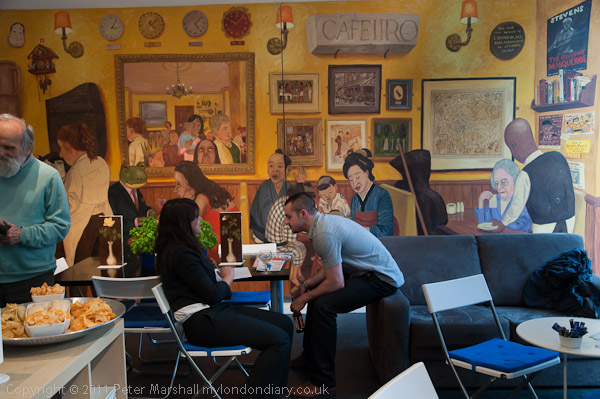
The Queen’s Terrace Café is a real café
in Queen’s Terrace NW8 with excellent food from 9am - 6 pm Mon-Fri
more pictures
One of the most enjoyable art shows I went to in 2009 was Café Jiro, an installation in the Flowers Gallery in Cork St, London by a friend of mine, the Japanese artist Jiro Osuga who grow up in north London. When he was 12 he came to the American school just a few hundred yards from the Queen’s Terrace Café in St John's Wood on Saturdays to attend Japanese classes.
The Queen’s Terrace Café, which opened in April this year is no ordinary café, but a cultural café, run by Mireille Galinou, who for some years ran an organisation called the London Arts Café, which never quite managed to open a café, but did organise a dozen or so exhibitions and numerous other art events in London. After leaving this she researched and published a book on the history of St John's Wood, Cottages and Villas: The Birth of the Garden Suburb, which was published by Yale University Press last year.
Café Jiro, showing in the Queen’s Terrace Café until 26 Aug 2011 includes one of the large wall-size panels from the Flowers show, along with a number of other works specially produced for this space - including three in the smallest room. It's a show that meshes well with the cultural and community agenda of the cafe, which you can read more about on >Re:PHOTO.
The small cafe was packed for the opening, and it was a great opportunity
to talk to a number of old friends, but I also took some pictures, which show
some of the works in a proper cafe atmosphere.
more pictures
Refugee Week Umbrella Parade
Embankment Gardens to South Bank, London. Sunday 19 June 2011
The parade makes its way across Hungerford Bridge to the South Bank
more pictures
Several hundred people marched through London behind a samba band carrying colourful umbrellas to celebrate the 60th anniversary of the UN Convention on Refugees and the start of Refugee Week 2011.
2011 is the 60th anniversary of the UN Convention on the Status of Refugees, adopted on 28 July 1951, and this year's refugee week celebrates those 60 years, reminding us of the enormous contribution made by refugees to the UK through their work in all spheres of life.
The umbrella represents our proud tradition of giving shelter and safety to those whose lives are in danger who seek asylum here and the bright colours were chosen to celebrate the diversity of those who have come here.
Among the agencies involved in Refugee Week, many of whom were represented in the parade are Amnesty International UK, British Red Cross, United Nations High Commission for Refugees (UNHCR), the Children's Society, Oxfam, Refugee Action, Refugee Council, City of Sanctuary, Scottish Refugee Council, STAR (Student Action for Refugees) and Welsh Refugee Council.
Several hundred people gathered for the parade in Victoria Embankment Gardens, where there were a couple of brief speeches before Samba band 'Rhythms of the City' led the way through the gardens and then back along the Embankment before crossing the Thames on the upstream Golden Jubilee Bridge.
Crowds watched the parade as it made its colourful and noisy progress along past the South Bank centre and National Theatre and on along the busy riverside walk towards Bernie Spain Gardens where this year's Celebrating Sanctuary festival was taking place.
The parade ended there and people left to enjoy the stalls, music and dance
and other activities there. Shortly after it arrived, those taking part in
Amnesty International's Umbrella Decorating workshop at the festival came
out to meet it.
more pictures
Solidarity with Nuba in Sudan
Downing St, London. Saturday 18 June 2011
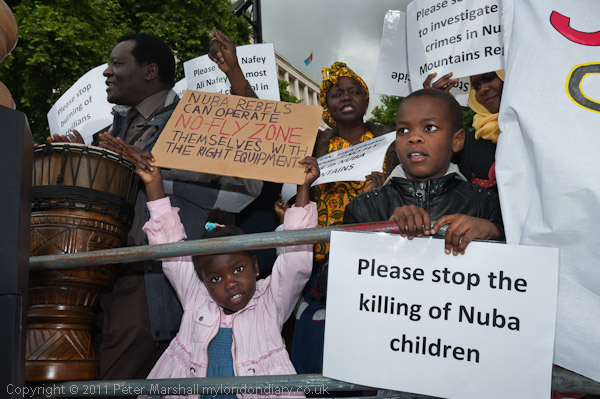
'Please stop the killing of Nuba children'
more pictures
Nuba Mountains Solidarity Abroad led a protest at Downing Street yesterday calling for urgent action against the ongoing genocide in the Nuba Mountains, Abyei and Darfar by the Sudanese regime.
Following an overwhelming majority vote in the peaceful referendum in January, Southern Sudan will become an independent nation on July 9, but arguments remain about the exact border between north and south, and the Sudan Armed Forces are reported to be preparing for a major offensive in Southern Kordofan.
Sudan's President Omar al-Bashir who seized power in a military coup in 1989 has had two arrest warrants issued by the International Criminal Court for his war crimes and crimes against humanity in Darfur, the second in 2010 including a charge of genocide.
Over a hundred protesters, mainly Sudanese resident in the UK where the human rights movement Nuba Mountains Solidarity Abroad is based were joined by the UK human rights organisation HART (Humanitarian Aid Relief Trust) founded by Baroness Cox of Queensbury who was there to show her support.
A large banner called on the UN Security Council to protect civilians in South Kordofan from the tyranny of Omar al-Bashir, and other posters called for an end to the ethnic cleansing and genocide of the Nuba people by the Sudan government - one read "yesterday Darfur - today Abyei". Others called for an end to the rape of Nuba women and the killing of children.
The protesters want effective intervention by the UN, including the setting up of a no-fly zone, as well as effective humanitarian aid for the region. They also called for Omar al-Bashir to be caught and sent for trial at the ICC.
Light rain had been falling most of the time I was there but the chanting
was accompanied by a couple of drummers and the protest was still going strong
after around an hour when torrential rain swept through Whitehall, and people
crowded together under the trees for shelter. I left the protest and jumped
on a bus.
more pictures
International Stop Tar Sands Day
Canadian High Commision, Grosvenor Sq, London. Sat 18 June 2011
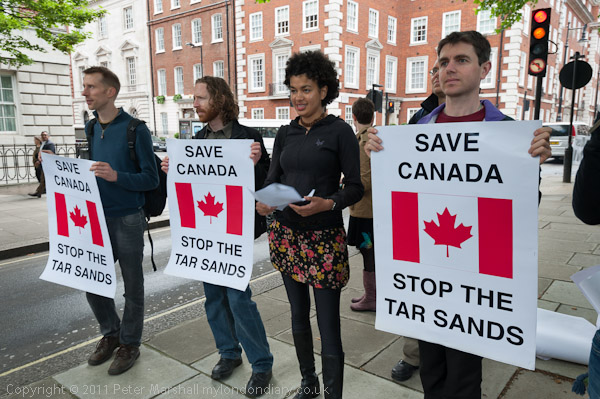
Save Canada - Stop the Tar Sands
more pictures
A protest outside the Canadian High Commission in Grosvenor Square highlighted Britain's shameful involvement in the world's largest and dirtiest industrial project exploiting the Alberta tar sands and blocking the EU's amended Fuel Quality Directive which would label tar sands as dirty fuel.
This protest was small in size but about an issue vital to the future of our planet. The Alberta tar sands are an area of 140,000 square kilometres covered by Albertan Boreal Forest which is being ripped up and bulldozed clear to extract them, destroying the forest, killing its wildlife and depriving local communities of the environment that provided their living.
Below the forest are the bitumenous sands from which oil can be extracted, but the process is much more polluting and requires considerably more energy than normal oil extraction, producing from between three to five times more greenhouses gases and leaving behind vast toxic lakes.
Because of the energy used in its extraction, the EU wants to amend its Fuel Quality Directive to distinguish between oil from tar sands and that extracted from less polluting sources, and to discriminate against it. So far all except two EU member states - the UK and the Netherlands have approved the amended FQD. Both countries have extensive interests in the companies - such as BP - which are involved in tar sands oil production.
Although there were some excellent and highly informed speakers at the event, there was no audience to hear them, just the small group of protesters and a few photographers. The eastern side of Grosvenor Square seems a very empty place on a Saturday lunch time, with very few pedestrians and only the occasional car passing.
The protesters had a few flowers they were going to lay at the doorway to
the embassy as a reminder of the wholesale deforestation and destruction of
ecosystems taking place in Alberta, but I left before they did so. They also
intend to hand a petition in to Norman Baker at the Department of Transport
on Monday.
more pictures
Russians Told 'Release Our Sister Sidikova'
Russian Embassy, Kensington, London. Saturday 18 June 2011
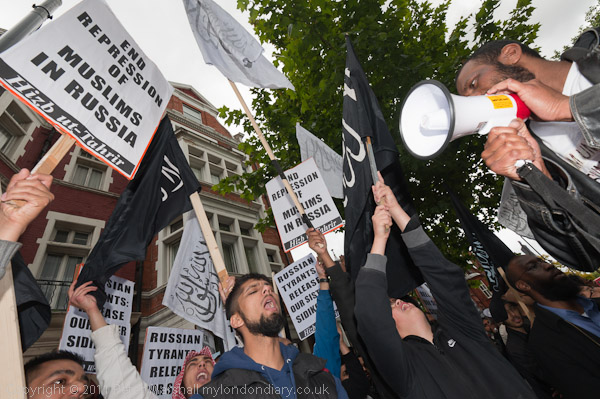
Hizb ut-Tahrir protest opposite the Russian embassy
more pictures
More than a hundred people demonstrated opposite the Russian Embassy in Kensington against the arrests and harassment of Muslims in Russia by the security agencies and calling for the immediate release of Sidikova Ganevna.
The protest, organised by Hizb ut-Tahrir Britain, was a part of an international campaign by Hizb ut-Tahrir to expose the oppression of Muslims in Russia and comes after a number of recent incidents. A simultaneous demonstration was taking place at the Russian embassy in Brussels, and there have been earlier protests in Jordan, Australia, Turkey and Indonesia.
Sidikova Ganevna was taken from her Moscow home on May 19 without being allowed to inform anyone of her arrest and her three children were placed in an orphanage. Her husband had been arrested in December 2010 and charged with membership of Hizb ut-Tahrir; her arrest is thought to be an attempt to get him to make a confession to various untrue allegations.
The Russian Supreme Court banned Hizb ut-Tahrir in 2003 as a terrorist organisation, and there have been numerous arrests since then. In 2007, 12 Muslims were imprisoned for attempting the violent overthrow of the state in a trial in which the only evidence against them was thier possession of Islamic literature, mainly that published by Hizb ut-Tahrir in 2003. Osman Bakhash, Director of the Central Media Office of Hizb ut-Tahrir last month claimed "The world over knows very well that Hizb ut Tahrir does not condone violence, nor has it ever resorted to any violence whatsoever in its long record as a political party", although its global leader since 2003, Ata Abu-Rishta, called for the "destruction" of various groups, including the Russians in Chechnya, in a speech broadcast on the BBC in 2006. However despite the rhetoric and the uncomprising attitudes of the organisation there seems to be little or no hard evidence linking it to any actual violence.
Various groups, including the Russian Human Rights Institute comment that repression against Muslims - roughly one seventh of the Russian population is increasing in Russia, at least in part as a deliberate policy against separatists in Chechnya, and that anti-terrorism operations by the state are creating large numbers of innocent victims who are left with no legal means of defence.
Last month secuirty agents in Ufa, the capital of the Republic of Bashkortostan, and one of the largest cities in Russia - over a million people, with a little under half Muslim - made a number of raids and arrests in Muslim households, harassing and arresting a number of Muslim women.
Among those who were searched, verbally abused and physically threatened was Elmira Yonnerova who was 8 months pregnant, and under the stress of the search in danger of losing her child. Other women were threatened with the removal of their children to orphanages and knives and other weapons were waved at their faces.
The searches appear to have been mainly aimed at finding unlawful written material, particular that of Hizb ut-Tahrir, or of any other material linking them to this proscribed organisation.
The demonstration was still continuing when I left after around an hour as
torrential rain was falling.
more pictures
I'm a Photographer Not A Terrorist
AoP Gallery, Shoreditch, London. Tuesday 14 June 2011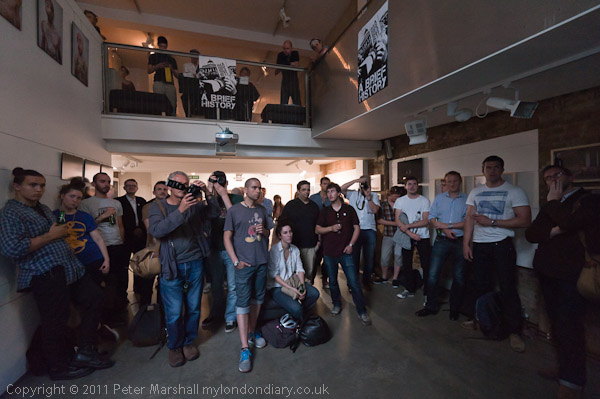
Photographers in the gallery at the launch
more pictures
Photographers had been fed up for some time at the frequent harassment by police when they were working, particularly with police officers in FIT teams taking photograph after photograph of us, often at close range at almost every demonstration. Despite showing press cards to identify themselves (a scheme set up in collaboration with the police and officially accepted by them) photographers were often being stopped and searched and sometimes detained for short periods while working. In some cases officers threatened photographers and insisted they delete images, despite clear laws against this.
But the final straw that led to a group of photographers taking action was an advertising campaign by the Met which I commented on in January 2008 which suggested to the public that anyone with a camera was a terrorist. Tbhe next month it became even more specific and the NUJ organised a one-person 'Press Freedom' protest by General Secretary Jeremy Dear in March 2008 when around 20 of us turned up at New Scotland Yard (in the SOCPA zone where larger demonstrations without police permission were illegal) to photograph him making the protest.
Out of this the 'I'm
a Photographer Not A Terrorist' organisation came into being,
uniting photographers from the various professional bodies with amateurs in
a series of events and protests. Photographers and police still come into
conflict at times, but our activities have led to a greater public awareness
of the problem and to generally less aggresive police attitudes towards photographers.
Of course there are still problems, both with police and with private security
guards, but in general we seem to have had some success with the campaign,
and the National Union of Journalists and the Campaign for Press and Broadcasting
Freedom sponsored a leaflet giving a brief history of the fight.
more pictures
Atos, Giz A Job!
Triton Square, London. Tuesday 14 June 2011
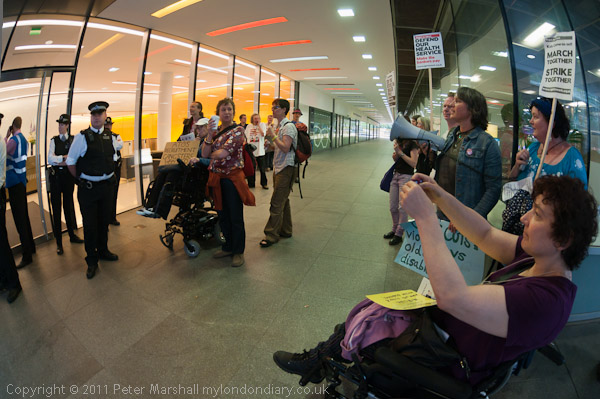
Clare from Winvisible takes a photograph outside the Atos offices
more pictures
Disability activists picketed the recruitment day at the London offices of Atos Origin who carry out the discredited 'health tests' to determine fitness to work of claimants and deny them benefits.
The 'Giz A Job - Atos Origin Recruitment Day' picket by around 50 people including those from Disabled People Against Cuts (DPAC), London Coalition Against Poverty, Mental Health Resistance Network and Winvisible Network made clear to the few people who came to the event the nature of the testing carried out by Atos, which signs off many clearly disabled people as "fit for work." In doing so, Atos is clearly wrecking the lives of some of the most disadvantaged in our society, in some cases leading to their deaths.
People with terminal illnesses, in the advanced stages of MS and with debilitating mental health problems have all been told they are capable of work. At least one person has actually collapsed and died in the test centre following such a decision, and several have been driven to suicide by their despair at Atos decisions.
Around 70% of those who appeal against the results of these tests are succesful, but the appeals are slow and difficult for many of the disabled. By the time appeals are held and granted people are often due for their next six-monthly test, where they are often again wrongly found fit to work, recquiring them to appeal again. At least one man killed himself when he heard, after two succesful appeals he had been turned down for a third time.
Atos tests use a computer based system that simply fails to take into account the very different nature of disablities, and relies on those administering the test to make snap judgments as to which box to tick which often entirely misrepresent the person being tested. One poster carried by a protester highlighted the case of June Mitchell, who failed to acheive any score as disabled on the Atos test despite suffering termninal lung cancer.
Having been standing behind barriers erected by the police for around an
hour, the protesters decided to be a little more active, and walked around
the barriers to continue the protest directly outside the offices. Police
tried hard to keep a clear route on the pavement and asked the protesters
to keep moving but otherwise alloweed the protest to continue.
more pictures
Naked Bike Ride
Hyde Park & Westminster, London. Saturday 11 June 2011
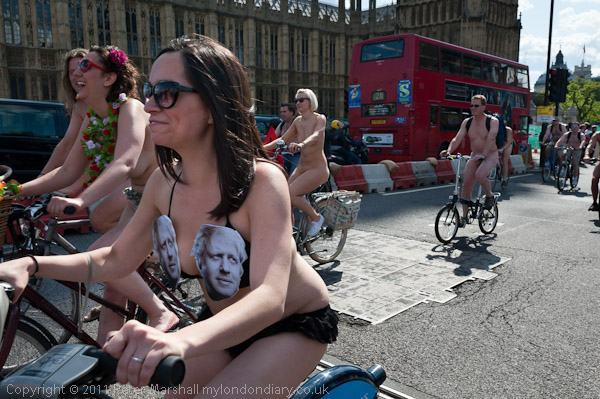
There were plenty of Boris bikes on the ride but this was more Boris than
most
more pictures (Warning:
include some nudity)
More than a thousand cyclists, many naked or near naked, cycled around the sights of London in an environmental protest against car culture and and oil-based economy.
At around 3pm, the thousand or more cyclists who had gathered for the ride in London's Hyde Park were told they could remove any clothing that they wished to get ready for the ride. Those who did so, particularly the women, were soon surrounded by a large crowd of tourists and photographers snapping away.
Now in its eighth year the event has become a part of the tourist calendar, with listings on the major events sites for visitors and in newspapers and magazines. The attempts of the event organisers to enforce any photography policy' was made a nonsense by the crowds and any serious photography was also extremely difficult. I tried hard to find pictures that showed what the event was about rather than concentrate on nudity. The ride allows those who take part to be as naked as they wish - except that wearing something on the feet is essential. Otherwise some of those taking part were completely naked, some wearing body paint, many wearing only shorts or bikinis but others wearing more than I was taking pictures normally dressed for the weather. Something that also often fails to come out of pictures of the ride is that a fairly large majority of the riders are male.
The ride started around 3.45pm, and I photographed many of the riders as they made their way out of Hyde Park. As on previous occasions, relatively few of them had legible slogans or placards on themselves or their bikes, and for many of those watching the event on the streets of London the message of the protest was far from clear. But it still created a great deal of interest, not just for the nudity but also for the body paint and costumes of many of those taking part. New this year were many 'Boris Bikes' in the ride, including one ridden by a woman with two portraits of the tousled-hair Mayor pinned strategically to hide her bikini top. Another Boris rider was there with a large 'Birthday Girl' Badge, celebrating the event in tassels, lacy pants and long white stockings.
One idea behind the protest is to emphasize how vulnerable cyclists are and feel when on the streets and to push for greater driver awareness and more safety measures. This year there was virtually no policing of the demonstration and cyclists mixed with London's normal traffic on busy roads, making the protest considerably more chaotic and hazardous than in previous years.
It also meant that the ride, which started off in dribs and drabs taking
15 minutes for the thousand or so riders to leave Hyde Park, was soon split
up into small groups and spread out by traffic and traffic lights. I caught
up with some of the ride again as they came through Westminster, going down
Whitehall and across Westminster Bridge. By this time it was so spread out
that it hardly seemed like a mass ride at all, although there were a few larger
groups of riders, while it earlier years a thousand of so riders together
made quite an impressive sight. But apparently the ride regrouped after I
had gone home to ride up the Mall en masse and sing Happy Birthday to the
Queen.
more pictures (Warning: include some nudity)
Syrians Protest At Embassy
Syrian Embassy,Belgrave Square, London. Saturday 11 June 2011
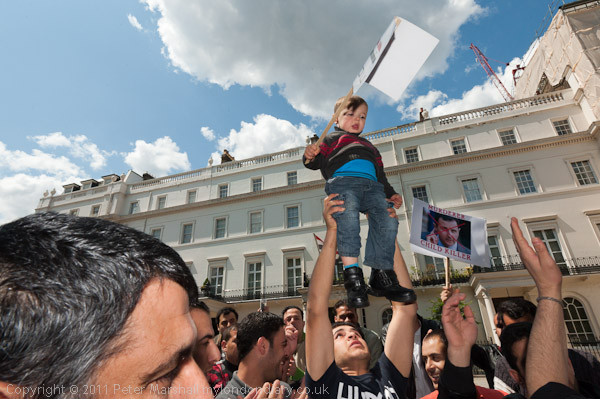
A young protester is held up above the crowd opposite the embassy
more pictures
More than a hundred Syrians held a peaceful but noisy protest opposite the Syrian Embassy in London's Belgrave Square against government attacks on the Syrian people for holding peaceful demonstrations in Syria. The called for President Bashar al-Assad and his regime to go and for democratic changes in their country.
The protesters were particularly appalled at the news currently emerging from Syria, including reports of the use of helicopter gunships against peaceful protesters in Maarat al-Numaab and the 'revenge' attacks against villages around Jisr al-Shugour, where crops have been burnt, livestock killed, olive trees uprooted and villages destroyed and tanks are now said to have sealed off the town, from which around 80% of the people are said to have fled to Turkey.
While I was there the men were chanting, jumping up and down, clapping and waving arms vigorously at the Syrian embassy across the road, while the women mainly stood to one side and demonstrated more quietly, with a number of them filming and photographing the men's protest.
Among the protesters who told me they represented Syrians of all groups and religions were Kurds from northern Syria, and as well as many Syrian flags there were one or two with Kurdistan flags on display.
The embassy was guarded by a couple of armed police and more officers were waiting nearby in a van, but the protest remained peaceful and made no attempt to approach the embassy, where there were no signs of life.
The embassy was guarded by a couple of armed police and more officers were waiting nearby in a van, but the protest remained peaceful and made no attempt to approach the embassy, where there were no signs of life.
Slutwalk London
Piccadilly to Trafalgar Square, London. Saturday 11 June 2011
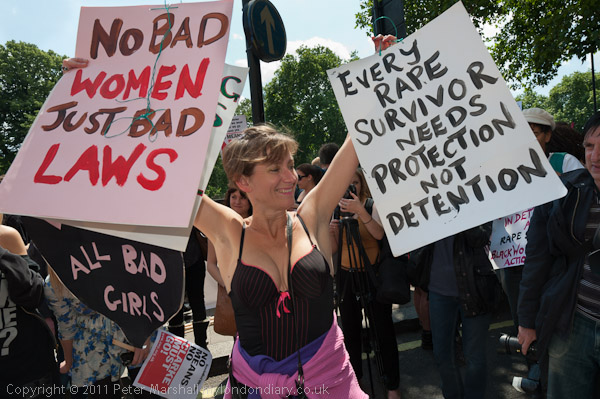
There were plenty of placards up for grabs at the start
of the Slutwalk
more pictures
Several thousand people, mainly women, many dressed in deliberately provocative fashions, marched through London demanding their right to wear what they like and to be safe.
Women (and men) around the globe were enraged when they heard that a Toronto police officer had told students "women should avoid dressing like sluts in order not to be victimized." They reacted against the way that this showed a transfer of blame in the police mind from the criminal to the victim, and in particular to the use of the clearly pejorative term 'slut' to describe these innocent victims of a crime that is already seriously under-reported because of the shame and opprobrium many who suffer it feel, in part from negative police attitudes.
In reaction, women decided to re-appropriate the word 'slut' and organised a 'slutwalk', marching in provocative clothing and making clear that rape was a crime, that rapists were criminals and it was the job of the police to protect people on the street and arrest and get convictions of those who committed crimes, and not to blame the victims for the crime.
The clear message from the chants and many of the placards was that 'Yes means Yes and No means No' and that sex should be a matter of consent rather than an exercise of male power.
Women should feel free to go out on the streets dressed how they like - whether burkha or bikini - and be safe. An attractive dress is an attractive dress and not an invitation to rape.
Several thousand people, mainly women,many dressed in various ways as sluts to make their point and with a great assortment of mainly hand-made placards and posters, gathered close to on Piccadilly close to Hyde Park Corner. As well as the basic message over dress, many also were protesting about male violence against women in general and over many issues concerned, including the failure of the UK immigration authorities to take seriously the accounts of rape given by many asylum seekers and the use of rape as a military weapon in Libya and elsewhere.
They also demanded better education about the myths and facts of rape in schools, workplaces and for trade unions, as well as improved legal, emotional and practical support for the victims of sexual assault, rape and domestic violence.
Many of those taking part also stressed the increasing problems caused by cuts in public services, with support services and legal aid suffering. Many of the problems that lead to domestic violence are also exacerbated by the lack of decent affordable social housing, which also often makes it difficult or impossible for victims of domestic violence to leave the family home.
I left the protesters as they marched past Piccadilly Circus on their way
to a rally in Trafalgar Square.
more pictures
On Street Photography Opening
Photofusion, Brixton, London. 9 June 2011
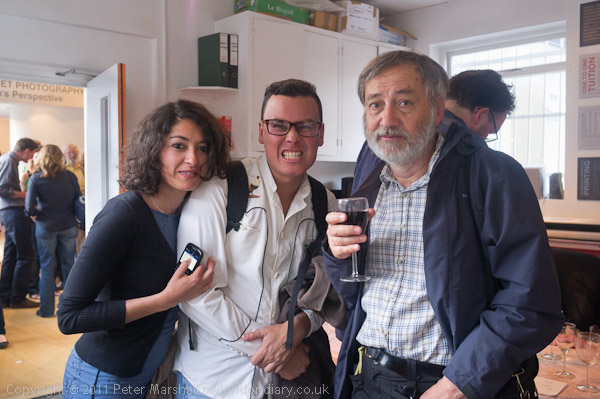
I was there - with a rather full glass of wine and looking rather worried.
more pictures
On Street Photography: A Woman’s Perspective opened at Photofusion
on 10 June and continues until 22 July with pictures by Anahita Avalos, Polly
Braden, Tiffany Jones, Johanna Neurath and Ying Tang. Some pictures from the
opening taken on my Fuji X100, all except this one by me.
more pictures
Heygate Estate Scandal
Heygate Estate, Elephant & Castle, London. Sunday 5 June 2011
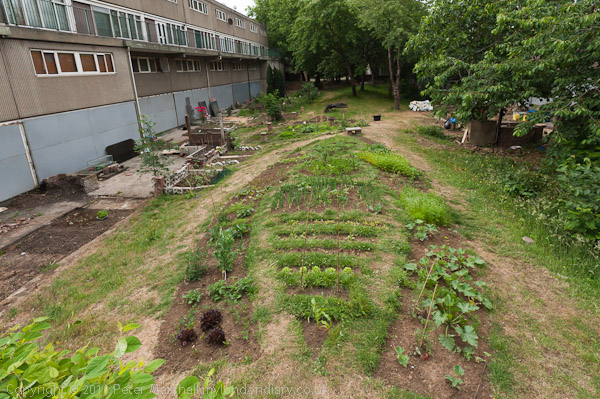
Residents evicted, council will demolish in 2014-5; private development profits,
council tax payers lose - but now some land is taken over by people to grow
crops.
more pictures
London's Heygate Estate, 25 acres in a prime position next to the Elephant and Castle in Southwark has had a bad press. Completed in the early 1970s and home for years to more than a thousand families it was a brave and farsighted attempt to provide high quality social housing in a remarkably green development for its time. Given proper management by the council over the years it would now be seen as perhaps the most succesful development of its era. Instead it is a rotting, empty ghost city, waiting to be demolished and replaced by lower quality development making huge profits for the private developers.
The developers got a bargain, paying only £20 million for the site and gaining the direct and indirect advantages of some £1.5 billion of public funds going into the Elephant redevelopment scheme. The council will still be paying for years for the estate which had 40 years of useful life left, and the demolition is vastly expensive. It is hard to see any rational explanation for what has happened here and in some neaerby Southwark council estates, a scandal on a huge scale.
Heygate had the disadvantage of being built at a time when architecture was passing through a visually brutal phase, and the vast slab blocks that surrounded it to create an oasis inside were on a massive scale. It didn't look a friendly place from the outside, and in the early years before the many trees that were planted grew it was a little bleak inside. Now the trees have reached maturity - and have considerable economic value but seem almost certain to be largely bull-dozed as the site is given over to flashy looking low cost high price flats for high paid workers - with the usual gesture towards providing some "affordable" housing. The estate will be developed with more than twice the current density, leaving little room for trees and grass.
Somewhere Southwark Council lost the plot - or rather changed to a very different one - and made a concerted and largely succesful attempt to change what had been seen as a good place to live into a sink estate, through a lack of maintenance and using it to rehouse "problem families"; coupled with a great deal of bad press and TV documentaries - those walkways made for some great images and it was so handy to get to. The council describe the scheme as 'failed architecture' but in reality it was the council that failed it, and the architecture is still in excellent shape - and likely to have been longer-lasting than its proposed replacement. They even engaged PR consultants to blacken the images of the estates they wanted to flog off on the cheap.
You can read more of the story of how the Heygate was demonised in The Guardian article from March 2011, The death of a housing ideal and more about its present state at the blog set up by one of the few remaining residents, Adrian Glaspool - a good place to start is here. For more detail see the Southwark Notes blog, which has a great deal of information and comment on the council's actions here and elsewhere in the borough. If much of what they have done is not illegal there is something very wrong with our laws.
After deciding to demolish and sell off the estate was taken, the council started encouraging tenants to move out in 2007, giving them a six month time limit to find replacement homes (they had stopped giving secure tenancies in 2001, meaning that they had no obligation to rehouse the roughly one third of tenants who had moved in since then.) They were supposed to do so through the council's Homesearch scheme, but nothing like the required 700 or so of properties were available in the area. Evictions and compulsory purchase along with less legal measures (shades of Rachman) were eventually used to more or less clear the estate, with just a handful of residents now remaining. Labour councillors when in opposition accused the council of "strong-arming and intimidating tenants and leaseholders out of their homes on the Heygate" but little seemed to change when they were voted in in 2010.
Leasholders on the estate were treated in a particularly shabby fashion as the Council carried out a programme of what was essentially forcible removal from the estate. The leaseholder's action group site states:
"Leaseholders were left to watch as their neighbours were moved out one-by-one, leaving them all alone in blocks infested with vermin. Vacated properties were not cleared before being sealed up, lifts were turned off, the district heating & hot-water system was turned off, estate lighting was turned off, cleaning services and rubbish collections reduced and postal services dropped."
Also on that site you can find details of the ridiculous undervaluation of properties made by the council:
Elderly leaseholders or those with language difficulties came off particularly bad, and the council was able to convince some to accept offers as low as £32,000 for a 1-bed flat and £66,500 for a 3-bed maisonette.
Similar properties to the maisonette in this area cost around £300-400 a week to rent, and the market price is probably between £175-250,000.
The blog quotes environmentalist Donnachadh McCarthy, writing in the 'Southwark News' describing the demolition of the Heygate and Aylesbury estates as 'one of the biggest carbon crimes of the decade by a local authority.'
Like other buildings of its age the estate contains considerable amounts of asbestos, not a great safety hazard unless disturbed, but making the job of demolition of these structurally sound buildings difficult. For this reason it will be perhaps another four years before the demolition of the larger blocks actually starts although almost all the tenants and leaseholders have been forced out and the estate allowed to become derelict.
Recently a fringe area of the estate has been demolished, but work is not timetabled to start on the rest until late 2014 or early 2015. In April this year, some of the few remaining residents decided to clear the former garden areas and use the space to grow flowers and vegetables, informing the council who at first started legal proceedings for 'unlawful gardening' but then entered into talks aimed at authorising and controlling the allotments.
It is easy to photograph estates like these and make them seem very inhuman
places, especially when they have been deliberately vandalised and left to
rot. But until the council deliberately ran it down, the Heygate was a popular
place to live, and surveys showed this. The planning that went into it by
Southwark borough architects under Tom
Tinker was largely vindicated. Had it been owned and looked after by the
City of London it would still be at least as popular as the Barbican.
more pictures
Heygate Panoramas
Sunday 5 June 2011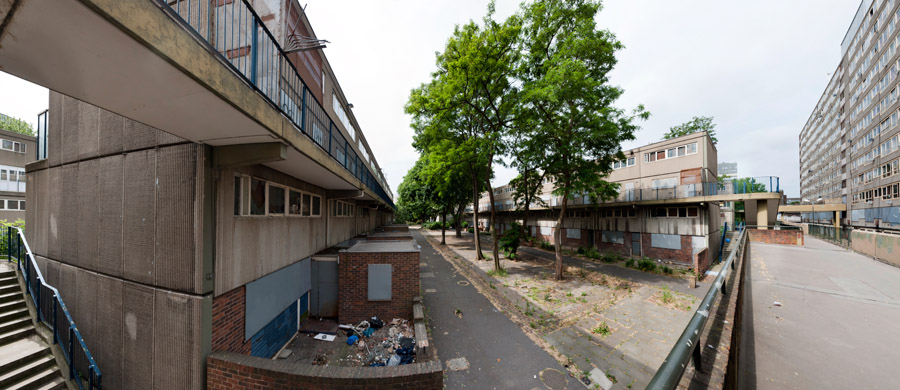
Wide pedestrian walkways and trees - with traffic away from housing
more panoramas
Lewisham Funeral For the NHS
Lewisham, London. Saturday 4 June 2011
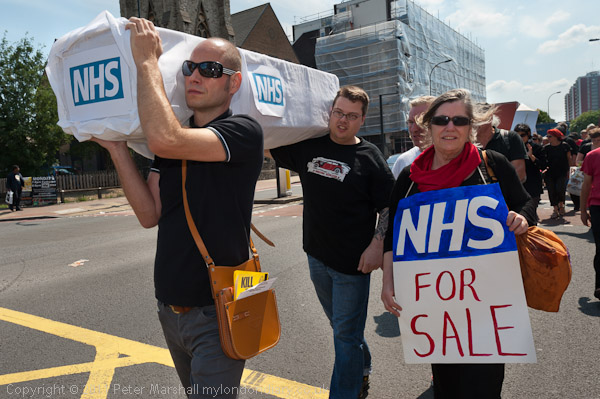
'A funeral procession to mourn the loss of universal health care'
more pictures
Protesters sang outside Lewisham Hospital before marching into the town centre market where they performed a short theatre piece against government plans to privatise the NHS.
Although the government in public plays down the effect of their proposed reforms, claiming that the NHS will not be privatised, a senior member of David Cameron's panel of health policy experts, Mark Britnell, made their plans clear in talking to healthcare companies last October at a conference organised by private equity firm Apax Partners.
In the seminar report on the Apax site, recenlty commented on by the independent non-profit organisation Spinwatch, Britnell stressed the huge opportunites coming up for private healthcare providers in the next cople of years, saying "The NHS will be shown no mercy" and that in future it "will be a state insurance provider not a state deliverer."
The protesters from Lewisham Keep Our NHS Public who gathered outside the University Hospital Lewisham at lunchtime on Saturday were quite clear about the government's intention to sell off at least the more profitable parts of the NHS. It will mean the end of a universal healthcare provision, and those with more complex problems and needs will fail to get the care they need.
The government plans are based on a failing US model, where a large proportion of the population are unable to afford health insurance, and those who have it and need complex treatments often find that their insurance will only cover a fraction of their medical costs. Some of these problems were dramatically shown in the short street theatre peice the group performed in the centre of the market in Lewisham High Street, as well as in the songs sung by the 'Strawberry Theives' socialist choir (agumented by members of 'La Chorale des Sans-Nom', visiting from Nancy, France.)
The proposed reforms, with their emphasis on competition will erode the cooperation between different services and institutions which is vital for the efficient provision of the high quality health provision which the government state as their aim. Virtually everyone who has seriously examined the NHS has stressed the need for greater cooperation to cut down waste and improve the patient experience, the Lansley Bill and government cuts will make the situation worse.
The NHS is urgently in need of reform, but not the destructive proposals currently before the Houses of Parliament. There is indeed a much better, more pertinent and closer model for its reform - without massive privatisation - north of the border in Scotland.
The protesters had planned to perform some of their protest songs outside the Accident and Emergency Department of the hospital, but after a couple of them had assessed the situation there decided that they could possibly be in the way of patients being brought there in an emergency and so simply walked along the main road into the centre of Lewisham. At one point they stopped and stepped to the edge of the pavement to allow an Emergency ambulance to speed by, its siren wailing. It was a reminder that the NHS too is facing an emergency.
Many of those who saw the protest stopped briefly to take the leaflets and
show their approval for the campaign to 'Kill the Bill'. They were urged to
e-msil their MP with their objections and to write to Nick Clegg urging he
reject the bill and to sign the online 'Save the NHS' petition. Lewisham Keep
Our NHS Public who organised the event also offered to provide speakers for
workplaces, churches and community groups to explain the threat to the NHS.
more pictures
top of page
All pictures on this section of the site are Copyright © Peter Marshall 2011; to buy prints or for permission to reproduce pictures or to comment on this site, or for any other questions, contact me.

